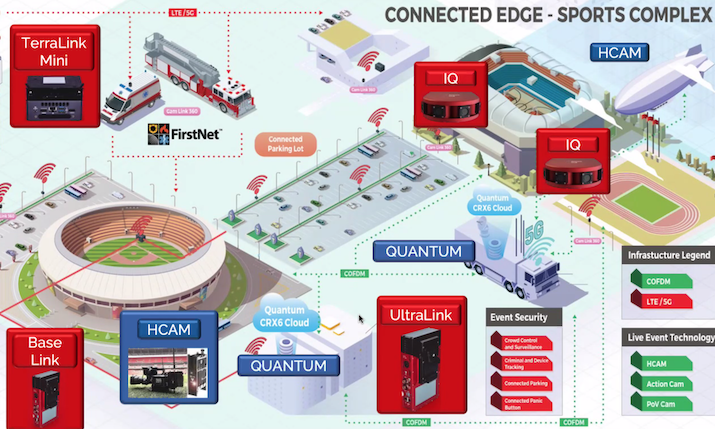Mobile Viewpoint and Vislink report strong results as product updates focus on further integration

Vislink and Mobile Viewpoint’s vision of the Connected Edge
Vislink has revealed third quarter results which show revenues for the nine months to September 2021 were $22.8 million, up from $16.1 million in the same period the previous year. The company believes the acquisition of Mobile Viewpoint earlier this year helped to strengthen its financial position, which also saw Vislink end the quarter with $38 million in cash.
As Mickey Miller, CEO at Vislink, says: “The key point is that we’ve done a lot of work around integrating our products. In our first quarter results since acquiring Mobile Viewpoint we had one of our best quarters ever; revenue increased 133% on prior year and 47% from the previous quarter. We continue to look for opportunities to augment our capabilities with additional acquisitions.”
While the focus continues to be on the company’s core areas of remote production and wireless cameras, this is now being augmented by the capabilities offered by Mobile Viewpoint in areas such as 5G and artificial intelligence (AI). The result is a number of new innovations, including the BaseLink 5G portable live streaming solution which is able to bond together 5G network signals that can be public or private. It is designed to enable anyone from anywhere to produce and distribute content and is aimed at small and mid-size content owners and broadcasters that require a low-cost, high-quality video streaming solution, as well as larger broadcasters that require an on-the-go alternative for their teams.
Michel Bais, managing director, Mobile Viewpoint, says: “We see a big opportunity around public and private 5G networks together. You can have a private network, for example to cover a golf course, but there’s public 5G too so if you go too far away you can continue transmissions from your live reporter on the pitch.”
The past year has also seen Vislink supporting 5G standalone cells whereby both uplink and downlink are 5G, rather than the current scenario whereby networks are typically 5G on the downlink, but not on the uplink. Indeed, 2021 saw Vislink and Mobile Viewpoint introduce the world’s first standalone 5G network for BT Sport at the British Brand Prix MotoGP at Silverstone.
Miller says: “We were really encouraged by what we saw there and both BT Sport and MotoGP were very excited about the capabilities and possibilities that 5G could bring.”
Bais adds: “The benefit of 5G is that you get so much more capacity – 5G is really the future for us.”
Mobile Viewpoint bonded cellular encoders are also receiving updates to provide lower latency transmissions as the product line fully transitions to 5G. This will enable higher upload speeds and higher quality video, in turn lowering content acquisition and distributions costs and making new programme streams profitable.
This is all part of Vislink’s wider vision of the Connected Edge, creating a complete ecosystem around a production such as a sporting event.
Bais paints a picture: “For example, the Vislink HCAM can take care of the very high quality and low delay footage while the traditional Mobile Viewpoint transmitters are used for sideline reporting, crowd control and also public safety. At the other end, are automatic sport production. At a smaller sports event it might be more interesting to go fully automatic using AI technology with our AI SportsProducer.”
Here too there have been updates, with PTZ camera capabilities now available for the IQ SportsProducer AI-assisted live sports solution. This is designed to offer more accurate and immersive tracking and enhanced detail from a single camera unit.
Bais explains: “The one thing users really wanted was a real camera so we can point, based on AI technology, a real camera in the right location. We can now control from our IQ SportsProducer a real PTZ camera and switch automatically between different robotic cameras and create the feeling of a fully manually produced sporting event.”
Also updated is the Mobile Viewpoint vPilot AI-based live studio production system, which now supports switcher integration via a third-party add-on. This allows the system to benefit from features such as picture-in-picture to deliver more natural and fluid automated coverage of studio productions.
“This means we can now leverage important features like fade control that are possible with switchers from manufacturers such as Blackmagic and Grass Valley,” adds Bais.

Mickey Miller, CEO, Vislink
Returning to the theme of the Connected Edge, Miller says: “The acquisition of Mobile Viewpoint continues our quest to complete the Connected Edge. The Connected Edge is all about taking devices on the edge and connecting them to the internet through different types of mediums, whether it’s satellite, 4G, 5G, Mesh, WiFi6, and wrapping big data around that to make decisions in real time. 5G allows you to have multiple cameras at an event but the cost points become incredible for having all wireless cameras as well as PoV cameras. With AI wrapped over the top, it allows you to do this at much lower cost. That’s where our focus continues to be and we’ll continue to pursue solutions that augment this.”
Remote production has, of course, been a hot topic for both companies this year and Miller believes it will only continue to grow in popularity and not just for COVID or cost-saving reasons.
“Robotic cameras to the cloud, remote production in the cloud and over the top distribution really bring down the cost base of the traditional workflows in broadcast. The main reason our customers have gone to remote production was because of COVID, but they’ve found a couple of things they see as very valuable. Number one, whereas before their producers would be on the road a lot, now they can have their best teams doing multiple different projects so that’s hugely favourable. They’ve also found from a talent perspective that a lot of their great people once they had families couldn’t be on the road for multiple weeks of the year so they would leave the industry. They’re now finding that remote production allows those talented people to stay in the industry. So we see when people look at remote production they don’t focus necessarily on the cost reduction, they see it as of value to their production by addressing those two issues.”
Continuing to look to the future and it’s a case of more of the same, concludes Bais: “We’ll see further integration looking at how we can develop our 5G roadmap even more based on feedback from customers. We see more and more requests for remote production and we see cloud production as the next thing to enable high-quality, low-cost production.”
